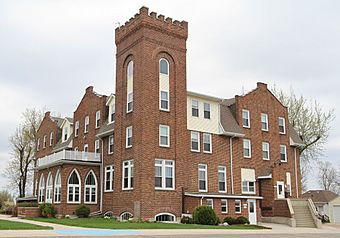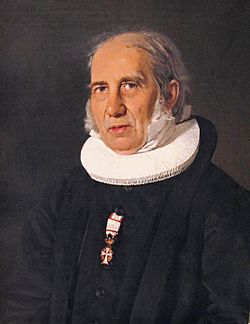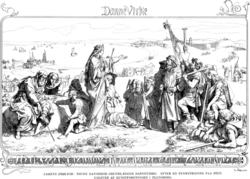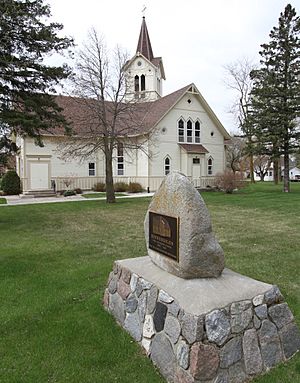Danebod facts for kids
Quick facts for kids |
|
|
Danebod
|
|

Danebod Folk School, 2018
|
|
| Location | Danebod Ct., Tyler, Minnesota |
|---|---|
| Area | 79 acres (0.32 km2) |
| Built | 1888 |
| Architectural style | b |
| NRHP reference No. | 75000993 |
| Added to NRHP | June 30, 1975 |
Danebod (say "DAHN-a-bo" or "DAN-a-bo") is a special historic area. It is located at the south edge of Tyler, a town in southwestern Minnesota. It was started in 1885 by Danish Lutherans, led by Pastor Hans Jørgen Pedersen.
This area has many old buildings from 1888. They are part of Minnesota's oldest settlement for Danish immigrants. Even today, Danebod is a strong Danish Lutheran community. Every July, they have a big party called Æbleskiver Days. It celebrates Danish culture with a parade and floats made by different neighborhoods.
Because of its history and unique buildings, four parts of Danebod were added to the U.S. National Register of Historic Places on June 30, 1975. This area is known as the "Danebod Historic Complex."
Contents
What Does Danebod Mean?
The name "Danebod" honors Denmark's first queen, Queen Thyra Danebod. She was married to King Gorm the Old in the 900s. Queen Thyra is famous for building a stone wall across Jutland, a part of Denmark. This wall helped protect her people from enemies. Because of this, she was called Danebod.
In Danish, the name "Danebod" means "someone who helps, comforts, or saves the Danes."
How Danebod Started
Before the Danish settlers arrived, the Dakota Sioux lived in this area.
A New Home for Danes

In 1872, two Danish pastors started a group that became the Danish Evangelical Lutheran Church in America. In 1884, a Danish farmer suggested finding land for Danish families who wanted to live in the countryside. A group was formed to find this land.
They worked with a railroad company to buy 35,000 acres (140 km2) of land in Lincoln County, Minnesota. For three years, this land was only sold to Danish people. The land was rolling hills near Buffalo Ridge, south of Tyler, Minnesota. By June 1885, seventy families from different states had moved there.
These first settlers were "Grundtvigians." This was a special group within the Danish church. They believed in celebrating life and were sometimes called "Happy Danes." They thought the Bible was holy but not to be taken word-for-word. They also loved their Danish heritage.
Grundtvigians wanted to keep Danish culture alive in America. They wanted to "save the Danes from becoming fully American." For many years, only Danish was spoken and written in Danebod. On June 28, 1885, the pioneers had a big party to celebrate their new home. By 1895, 222 people lived in the Danebod colony.
Growing the Community
In July 1886, the Danebod church group officially started with fifteen members. At first, they met in homes to sing Danish hymns. They didn't have a regular pastor.
In April 1888, Pastor Hans Jørgen Pedersen arrived with his family. He grew up in Denmark and became a leader in Danebod. He helped the community grow. One of his children, Sigurd Pedersen, wrote about their first day. He described how they found a small house and made a fire with old boxes.
In September 1888, the church group was given 77 acres (0.31 km2) of land. The Danebod Lutheran Church was officially opened on June 16, 1895. Pastor Pedersen passed away in 1905, and Pastor Thorvald Knudsen took his place.
Pastor Pedersen believed a Danish-speaking folk school was important for the community. The Danebod Folk School opened on December 1, 1888. One of the first students was Kristian Klink, a Danish stonemason. He helped Pastor Pedersen build the Stone Hall.
The Stone Hall was made from local rocks. Farmers brought rocks from Swan Lake, and Klink shaped them. It was finished in 1889. The Stone Hall quickly became the center of the colony. It was used for church services, weddings, and funerals. Students used it as a gym.
By 1892, the Stone Hall was too small for church services. So, they decided to build a new church. The Cross Church at Danebod was opened on June 16, 1895.
Early 1900s
In 1903, a Ladies' Aid society was started. In 1907, Sunday school began to be held during church services. A children's home opened in 1906. In 1912, a Folk School Association was formed.
The colony also had its first Danish elementary school for children, called Børneskolen. It was used until 1939. Ragna C. Olson, who lived in Danebod, described a school day in 1914. They learned religion, Danish reading and writing, history, and girls learned knitting and embroidery. In the afternoons, they learned English, writing, reading, and math.
On February 25, 1917, the Danebod Folk School burned down. Luckily, the fire was slow, and people saved much of the furniture. Nine months later, a new and bigger Folk School was built.
Around this time, a serious flu sickness spread, and churches and schools closed. Many people became sick. Then, on August 21, 1918, a terrible tornado hit Lincoln County. It was one of the deadliest tornadoes in Minnesota's history.
Danebod's Culture
Danebod has kept its Danish culture strong for many years. For decades, the schools, library, newspapers, and church services were all in Danish. Danish was the most spoken language until the 1940s.
Today, Danebod is still a very Danish-American town. People often fly the Danish flag, called Dannebrog. Danish cuisine, music, celebrations, language, and the Lutheran faith are still important. Until 1947, church services were only in Danish. Now, they offer one Danish service each week.
Danebod is sometimes called "the home of the Nissemænd." This refers to the mythological tomte from Danish stories. There's even a sign that says, "Welcome to Tyler. Home of the Nissemaend."
In the 1930s, the Danish-language Danebod Folk School closed because of money problems and fewer students. But it reopened in 1946. Since 1947, it has offered summer family camps. These camps teach Danish cooking, Danish folk dance, Danish art, and other Danish traditions. Campers sing Danish songs, dance, do crafts, and listen to talks about Danish culture.
There are many Danish celebrations each year. These include the town parade, Grundlovsdag (Danish Constitution Day), Fastelavn, and Æbleskiver Days. Æbleskiver are special round Danish pancakes. Æbleskiver Days is a very popular festival. It has been held for over a hundred years. During this two-day festival in July, Danebod celebrates its Danish heritage.
The festival has a parade with floats inspired by Danish traditions. You can also find traditional Danish foods like medisterpølse (sausage), frikadeller (meatballs), and smørrebrød (open-faced sandwiches). Other activities include folk dancing, art displays, singing, and a fair called Tivoli.
At Christmas, families still sing and dance around the Christmas tree in the Gym Hall. Some families celebrate Christmas Eve on December 24, as is common in Denmark. There's also a town fair on Danish Constitution Day, June 5. Many older people in Danebod still speak Danish.
Danebod Historic Complex
The Danebod Historic Complex is important for its architecture and culture. It was added to the U.S. National Register of Historic Places on June 30, 1975. It is located at 101 Danebod Court.
The complex includes four historic buildings:
- The Folk School (built in 1888, rebuilt in 1917)
- Stone Hall (1889)
- Cross Church or Danebod Lutheran Church (1893)
- Gym Hall (1904)
Most of these buildings survived the big fire of 1917, except for the Folk School, which was rebuilt. They also survived the devastating 1918 tornado.
All four buildings have a special shape called a "Greek Cross" floor plan. This shape often shows a religious purpose.
- The Danebod Lutheran Church (also called the Cross Church at Danebod) was opened on June 16, 1895. It is a wooden building shaped like a cross. Its tower is in the middle, turned at an angle. The church was built mostly by volunteers and money from the early settlers. Inside, you can see special altar chairs, old kerosene lamps, and hand-carved details. There are round "porthole" windows like on a ship. The church also has a statue of Christ by Bertel Thorvaldsen and a Star of Bethlehem in the ceiling. The church is part of the Evangelical Lutheran Church in America (ELCA) today.
- The Danebod Stone Hall was built in 1889. It is a single-floor stone building shaped like a Latin cross. It has medieval-style battlements at the entrance. It was built from rocks brought by farmers and shaped by a Danish stonemason named Kristian Klink. The Stone Hall was first used as a church, then as a gym and meeting hall. Today, it is a museum with old photos and items from Danebod's history. It is also used for activities and talks.
- The Danebod Gym Hall was built in 1904. It is a wooden building shaped like a cross. It was made for Danish gymnastics, folk dancing, music, plays, and large gatherings. Every Christmas, the Danebod Lutheran Church continues the Danish tradition of dancing around the Christmas tree in the Gym Hall. The basement is used for crafts like stained glass and woodworking. In 1928, a stage, basement, and furnace were added. It is still used for plays and folk dancing.
- The Danebod Folk School was first built in 1888. It burned down in 1917 but was rebuilt nine months later. The current building is a three-story brick building. It has a four-story tower and pointed arches at the entrance, like old Danish buildings. The Folk School was updated in 1946. Now, the Danebod Lutheran Church uses it for camps, retreats, and meetings. It has a hand-carved podium in the lecture hall and unique rooms. The early settlers started this school to help people learn "for living." It taught them to be thoughtful citizens. The Folk School still helps people learn and connect today.









